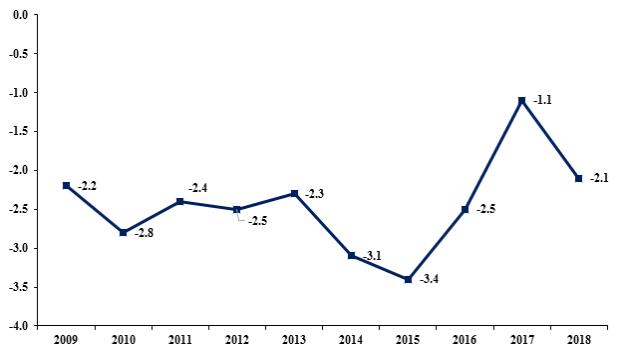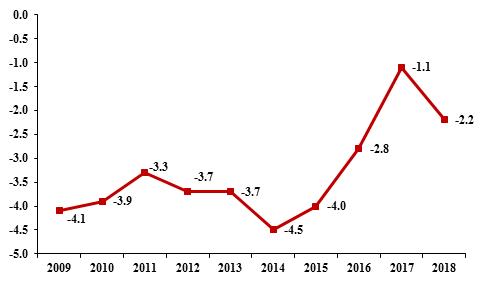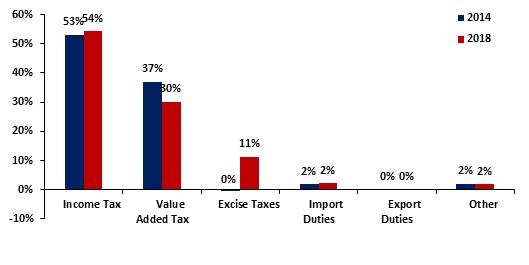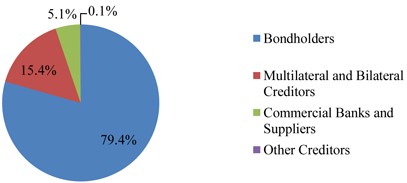As of December 31, 2018, INFONAVIT’s total equity amounted to Ps. 219.1 billion, an increase of 10.3% as compared to December 31, 2017. Also as of December 31, 2018, INFONAVIT’s total loan portfolio was Ps. 1,258.3 billion, an increase of 7.2% as compared to December 31, 2017. For additional information regarding INFONAVIT, see “Public Finance—Revenues and Expenditures—Health and Labor, Education and Other Social Welfare Expenditures—Other.”
Pension and Housing Fund Totals
As of December 31, 2018, the total amount of funds accumulated in housing sub-accounts managed by INFONAVIT and individual accounts of workers with AFORES was Ps. 4,731.1 billion. This figure includes transfers from the pension sub-accounts established with banks under the prior social security laws, as well as direct contributions under the new pension system and recognition bonuses for ISSSTE beneficiaries that opted for the defined contribution system.
During 2018, Ps. 4,473.4 billion was deposited in the pension and housing funds, Ps. 3,234.1 billion of which corresponded to deposits made to workers’ retirement sub-accounts and Ps. 1,239.3 billion of which corresponded to deposits made to workers’ housing sub-accounts.
Wages
Mexico’s minimum wage is set by the Comisión Nacional de los Salarios Mínimos (National Minimum Wage Commission), which consists of representatives of the business and labor sectors and the Government. On December 20, 2018, President López Obrador, along with authorities from the Secretaría del Trabajo y Previsión Social (Ministry of Labor) and the National Minimum Wage Commission, announced a new policy for determining the minimum wage. Under the new policy, Mexico has two minimum wages: one rate applicable to municipalities located on the border with the United States, which are included in a newly created Northern Border Free Trade Zone, and a different rate applicable to the rest of Mexico. The following minimum wages went into effect on January 1, 2019: Ps. 176.72 per day for municipalities in the Northern Border Free Trade Zone, a 100% increase from the minimum wage of Ps. 88.36 per day in effect prior to January 1, 2019, and Ps. 102.68 per day for the rest of Mexico, a 16.2% increase from the prior minimum wage.
For a table comparing minimum wage increases and changes in price indices, see “Financial System—Monetary Policy, Inflation and Interest Rates.”
Mexican law requires any businesses operating in Mexico to provide substantial worker benefits, including mandatory profit sharing through a distribution of 10% of pre-tax profits to workers. Other benefits include mandatory participation in the pension fund and worker housing fund systems.
Principal Sectors of the Economy
The principal sectors of the Mexican economy are manufacturing, petroleum and petrochemicals, tourism, agriculture, transportation and communications, construction, mining and electric power. In 2018, the services sector represented 66% of GDP and 62% of the workforce, followed by the industrial sector, which represented 31% of GDP and 24% of the workforce, and the primary sector, which represented 3% of GDP and 14% of the workforce.
Manufacturing
Mexico has developed its manufacturing sector with the dual goals of capitalizing on: (1) lower manufacturing overhead; and (2) its common border with the United States, its major export trading partner. Mexico’s current policies seek to strengthen the domestic market, encourage entrepreneurs and strengthen micro, small and medium enterprises, while fostering the social economy through improved access to financing.
Since 2014, Mexico’s total industrial manufacturing output has increased significantly. This expansion was primarily due to an increase in the manufacturing of primary metals and in the fabricated metal products and transportation equipment sectors, as well as an increase in manufacturing exports to the United States. Although automotive exports maintained a positive trend, other manufacturing exports continued to have slower growth.
D-41



